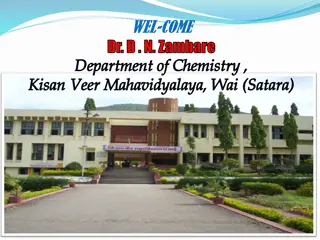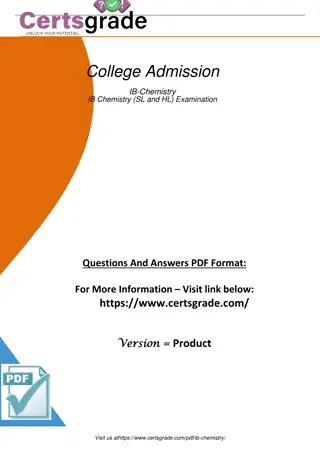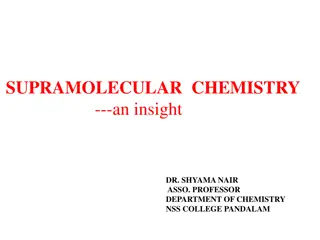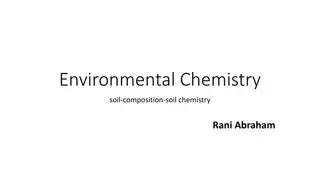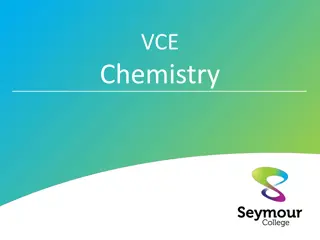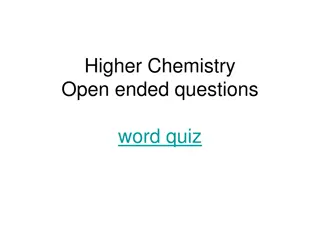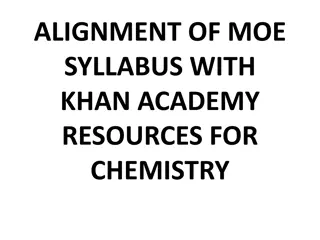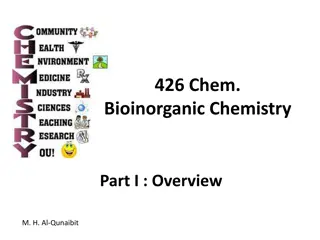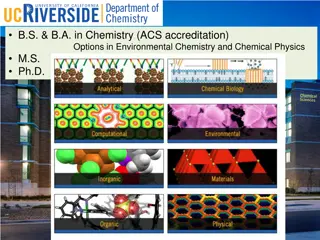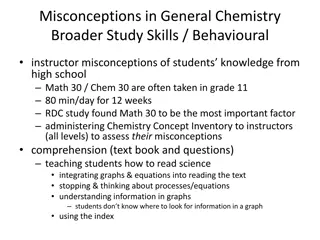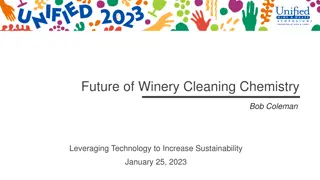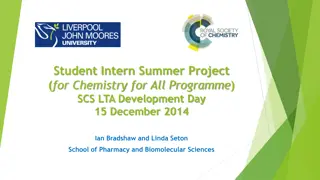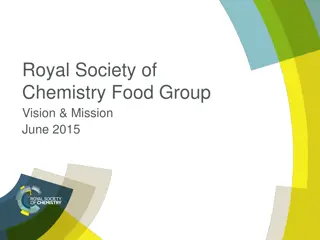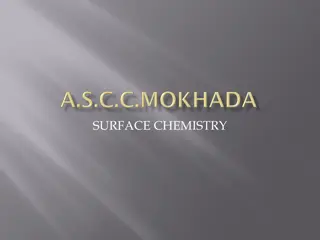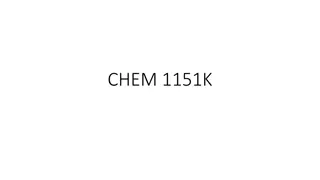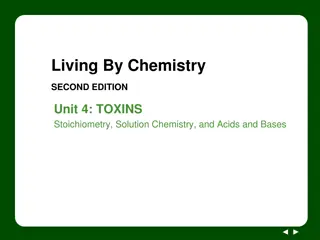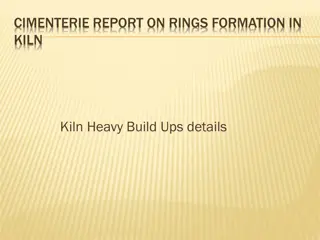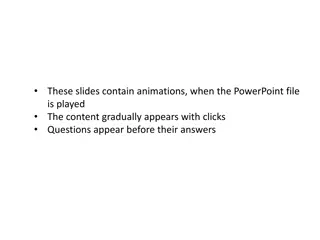
Understanding Chemical Reactions and Equations
Learn about chemical reactions, signs of chemical changes, word equations, phases in chemical equations, and the importance of balanced chemical equations. Explore the essential concepts and principles in chemistry to understand the transformation of substances through reactions.
Uploaded on | 0 Views
Download Presentation

Please find below an Image/Link to download the presentation.
The content on the website is provided AS IS for your information and personal use only. It may not be sold, licensed, or shared on other websites without obtaining consent from the author. If you encounter any issues during the download, it is possible that the publisher has removed the file from their server.
You are allowed to download the files provided on this website for personal or commercial use, subject to the condition that they are used lawfully. All files are the property of their respective owners.
The content on the website is provided AS IS for your information and personal use only. It may not be sold, licensed, or shared on other websites without obtaining consent from the author.
E N D
Presentation Transcript
Chemical Reactions are associated with chemical change. Whenever a chemical change occurs chemical reaction is said to take place Chemical reactions are usually irreversible and a new product is formed. During a chemical Reaction old chemical bonds are broken and new chemical bonds are formed which lead to the formation of new products
Signs of Chemical Reactions There are five main signs that indicate a chemical reaction has taken place: change in color Change in temperature Change in state Evolution of a gas
A WORD EQUATION describes chemical change using the names of the reactants and products. Write the word equation for the reaction of methane gas with oxygen gas to form carbon dioxide and water. carbon dioxide + water methane + oxygen Reactant Product CO2 O2 2 H2O 2 CH4 + +
The simplest form of description of a chemical reaction in a shorter form is by writing it in the form of an equation. E.g.- Mg + O2 MgO It a representation of a chemical change by the help of symbols of elements and formulae of compounds The reactants are written on the left side and product is written on the right side. An arrow is placed between them to show the direction of reaction.
The equation must represent the known facts and feasible chemical change The equation must contain the correct formulae of the reactants and products. The important conditions of temperature, pressure and catalysts during the reaction must be written on the top of the chemical equation The law of conservation of mass must be satisfied.
Showing Phases in a Chemical Equation H2O(s) H2O(l) H2O(g) Solid Phase the substance is relatively rigid and has a definite volume and shape. NaCl(s) Liquid Phase the substance has a definite volume, but is able to change shape by flowing. H2O(l) Gaseous Phase the substance has no definite volume or shape, and it shows little response to gravity. Cl2(g)
Chemical equations are of two types- Skeleton Equation and Balanced Chemical Equation. According to the law of conservation of mass, total mass must be equal on the both sides of the equation. This type of equation is known as a balanced chemical reaction. E.g.- 2Mg + O2 2MgO Here both sides have two atoms of Magnesium and two atoms of Oxygen. Hence the equation is balanced
Unbalanced and Balanced Equations H Cl Cl H H Cl H H Cl Cl Cl Cl H H H2 + Cl2 reactants products 2 2 2 HCl (balanced) (unbalanced) H2 + Cl2 reactants products H Cl 2 HCl 2 1 1 2 2 H Cl
Reactants 1 C atom 4 H atoms 4 O atoms Products 1 C atom 4 H atoms 4 O atoms
Visualizing a Chemical Reaction 2 2 Na + Cl2 NaCl ___ mole Na 10 10 ___ mole Cl2 5 5 ___ mole NaCl 10 10 ?
TYPES OF CHEMICAL REACTIONS 1. Combination reaction A + B AB AB A + B 2. Decomposition reaction A + BC AC + B 3. Single-displacement reaction AB + CD AD + CB 4. Double-displacement reaction 5. Redox reaction
The type of reaction in which two reactants combine to form a single product. E.g. A + B AB 1. CaO + H2O Ca(OH)2 2. C + O2 CO2 They are generally exothermic reactions which involve evolution of heat during reaction.
Combination Reaction 2 Na + Cl2 2 NaCl Na Na Cl Cl Cl Cl Na Na General form: A + B AB element or compound element or compound compound
Decomposition Reaction The type of reaction in which a single reactant breaks down to give two or more simpler product is called decomposition reaction. Ex: AB 2 H2O 2H2 A + B O2 + Decomposition reaction can be carried out by the supplying energy by means of heating, electricity or light. It is known as Thermal decomposition, Electrolytic decomposition and Photodecomposition reactions respectively
Decomposition Reaction Decomposition reaction 2 H2O + 2 H2 O2 H H O O H H + H H O O H H General form: AB A B + compound two or more elements or compounds
Decomposition Reactions Hydrogen Peroxide H2O2 H2O + O2 2 2 Electrolysis of water electricity 2 2 H2O H2 +O2 Nitrogen triiodide 13 2 NI3 N2 + I2 3 General Form AB A + B
The reaction in which a more reactive element displaces a less reactive element from its salt solution is known as Displacement Reaction. This is of two types:- 1. Single Displacement Reaction 2. Double Displacement Reaction
SINGLE AND DOUBLE DISPLACEMENT REACTIONS Single-replacement reaction Mg + CuSO4 MgSO4 + Cu General form: A + BC AC + B Double-replacement reaction CaCO3 + 2 HCl CaCl2 + H2CO3 General form: AB + CD AD + CB
lead (II) chloride + potassium iodide potassium chloride + lead (II) iodide Cl1- Pb2+ I1- K1+ Cl1- K1+ Pb2+ I1- K I Pb Cl2 + KCl PbI2 + (aq) (yellow ppt)
Double Displacement Reaction K2CO3 (aq) Potassium carbonate BaCl2 (aq) Barium chloride 2 KCl (aq) Potassium chloride BaCO3 (s) Barium carbonate + +
Element Reactivity Foiled again Aluminum loses to Calcium Ca
Redox reactions are those reactions in which both oxidation and reduction takes place simultaneously. If a substance gains oxygen during a reaction, it is said to be oxidised. If a substance loses oxygen during a reaction, it is said to be reduced If a substance gains hydrogen during a reaction, it is said to be reduced. If a substance loses hydrogen during a reaction, it is said to be oxidised Reactions in which this type of change occurs is known as Oxidation and Reduction reactions or Redox reactions. E.g. CuO + H2 Cu +H2O
Oxidising agent are those substances which makes available oxygen or removes hydrogen and helps reaction to take place and facilitates the oxidation process. Reducing agent are those substances which makes available hydrogen or removes oxygen and helps reaction to take place and facilitates the reduction process. Both oxidising agent and reducing agent facilitates Redox reaction
There are a number of redox reactions which take place in our daily lives. 1. Corrosion 2. Rancidity Corrosion is slow process of self oxidation in which a metal undergoes layer by layer destruction after reaction with atmospheric oxygen and moisture. Ex- Rusting of iron, tarnishing of silver, Copper turns green when exposed in air.
Rancidity is a slow process of self atmospheric oxidation of food containing fats and oils marked with unpleasant smell and taste. Ex- Butter turns rancid Ways to reduce rancity 1. Storing food in air tight container 2. Storing food low temperature 3. Storing food dark containers to stop reactions by the help of sunlight 4. Use of antioxidants such as BHT ( Butylated Hydroxy Toluene) and BHA (Butylated Hydroxy anisole)
Any Questions THANK YOU BY: NK SINHA

